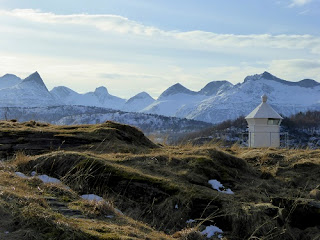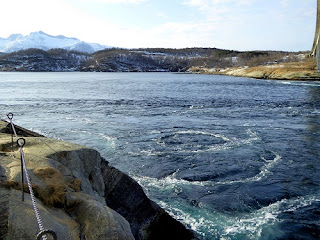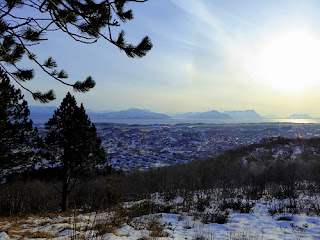Saturday, 31 March 2018
Above the Arctic Circle: coastline and maelstrom
Bodø, pronounced variously according to dialect but most often as 'Buda', not to be confused with the hilly side of Hungary's capital, lies 80 km north of the Arctic Circle on the Norwegian coast (trains from Oslo take 24 hours, with a change at Trondheim). It's an architectural mess of a town - it was bombed in the Second World War - with pockets of fascination, friendly people and a superb concert hall and library on the harbour recently constructed as an impressive act of civic pride. I travelled there to hear young violinist Eldbjørg Hemsing, brimming over with musicality in everything she plays and says, in a violin concerto by underrated turn-of-the-century Norwegian composer Hjalmar Borgström; not a masterpiece, but sincere, worth getting to know and a superb lyric showcase for an artist as top-quality as EH. The interview will appear on The Arts Desk to coincide with Graham Rickson's review at the end of April, when the CD is due to be officially released.
Since Bodø's chief attraction is as a base from which to see some of the most stunning nature anywhere, we visitors from the UK and Germany also had a full day's sightseeing itinerary planned for us, much of it under the aegis of hugely likable local Raymond Limstrand Jakobsen, the Voice of Bodø (says I). Had a hint of things to come in the view from my hotel window
as the sun rose on a day typical, I'm told, for this winter in Bodø - usually, as it's served by the Gulf Stream, it doesn't get that cold, but recent months have been stable weather-wise and well below freezing (with a wind-chill factor we were at around minus six in the day).
Raymond drove us first out, past ribbon development of the town which goes on for about ten miles, to Saltstraumen to see what's advertised as the world's largest maelstrom. There's a very big humpbacked bridge, quite an impressive feat of engineering, over the narrow channel which connects the outer Saltfjorden to the Skjerstad Fjord. Bald facts from Wiki: 'Saltstraumen has one of the strongest tidal currents in the world. Up to 400,000,000 cubic metres (520,000,000 cu yd) of sea water forces its way through a 3-kilometre (1.9 mi) long and 150-metre (490 ft) wide strait every six hours. Vortices known as whirlpools or maelstroms up to 10 metres (33 ft) in diameter and 5 metres (16 ft) in depth are formed when the current is at its strongest.' Which is at each day's two high tides, so we were there for the morning one.
First we walked along the shore line,
seeing the whirlpools from various distances
and getting a glimpse of the rich marine flora which goes down to a huge depth
and the birdlife - seagulls co-existing with, what, eider ducks perhaps, on a nearby rock
before walking up to the top of the bridge for some dramatic views down.
After a warming fish soup back at Bodø harbour, two of us joined a group of intrepid seniors fresh off the Hurtigruten coastal boat for a gentle walk along the coastline north of the town. We needed the spikes provided to attach to our walking boots (that took some time to sort out, and of course I put one of mine on the wrong way). The objectives of the two nice guides were to stop and inform us about three features, starting with a little geology down on the first sandy beach facing the impressive mountainous island of Landegode (the Lofotens are behind it, about 100km away, and could be seen from a higher vantage point later in the day). Interesting fact about the island, which I learnt from Raymond - it has forty inhabitants and four children, but there's still a school there for them. Oh enlightened Norway!
Though short, it was an attractive route between three bays, climbing gently to seaside woods
where we had a mini-lecture on Vikings on the supposition that we were standing around burial mounds (not sure if I believe this, sceptic as I am)
and I was more concentrated on the various lichens.
Then it was down again to a second beach with effective ice presence on what might otherwise have been a balmy seaside scene - I think I may have conflated it with the third bay in these pics -
with the sea a temptingly Aegean blue.
Back in Bodø after a warming tea made from a local herb on the coach, we were kindly driven by Raymond up to the local viewpoint - more impressive for seeing Landegode than looking down on the town, which hardly has any outstanding features
and for better views of the inland mountain range.
as well as close acquaintance, on the way up and down, with the icicles that have formed from water seeping out of the rocks broken to make the road.
We came back up here to see the Northern Lights that evening after the concert, and they were impressive in a ghostly kind of way, but not photographable. The nearest I was going to get to the true light show was above my hotel room bed,
and I'm told that on the night of my departure, they suddenly became truly spectacular and continued that way for a whole week. At least we saw them, and became childishly delighted at the sight, unlike the tourists with whom I shared my Reykjavík bay hotel a couple of Januarys back when I was in Iceland for the Dark Music Days Festival. More on the singularities of Bodø on a future post.
Tuesday, 27 March 2018
Devilish music-drama in Zurich and Lucerne
Catching Wagner's Der fliegende Holländer at Zurich Opera with the greatest living interpreter of the title role was serendipity, a bonus preface to my days at the Lucerne Easter Festival,
and I wasn't expecting an optional extra in Lucerne, the resident opera company's site-specific experiment with Schumann's Faust-Szenen, to have such an impact.
None of us present will ever forget the Zurich concert performance of Dutchman at the Royal Festival Hall. There Anja Kampe (pictured below with Terfel in production photos of the first run - no new ones were taken for this cast, sadly) and Matti Salminen were very much Bryn's equals in holding the stage. This time Steven Humes was, as they used to say, merely faxing it in as Daland; though if Camilla Nylund's more-lyric-than-usual Senta kept something in check in Act 2, it was worth it for the final transfixing commitment before the abrupt end of the tragedy (Zurich's version sticks to the brutal Dresden original, without the Tristanish epilogue in Overture and finale). There was huge intensity and interest in Marco Jentzsch's imposingly psychotic Erik, and promise for that role and other Wagnerian tenor parts from Omer Kobeljak's Steuermann.
If Bryn has suffered some of the vocal wear and tear inevitable in singing Wagner round the world across the four-plus years since his first Zurich Dutchman, he is still totally compelling. The colour and inflexion are there from the very first phrase ('Die Frist ist um,' spine-tingling), and the hyper-flexible, sensitive conducting of Markus Poschner enabled him to hover just that little bit longer in mid-phrase. Besides, he only has to stand there - or even, in one effective instance, sit to the left of the stage with his back to chorus and audience - to command the stage with his undeniable charisma. Irrelevant to the performance, perhaps, but a chorus member who told me that he was always solicitous in helping her find her way in the wings without her spectacles signalled that he's still the same team player whom I first encountered in person making tea for everyone in the Dundee recording sessions for Mendelssohn's Elijah.
The original photos of 2012 had made me keen to see Zurich Intendant Andreas Homoki's production. The concept is handsome in Wolfgang Gussmann's design: it all takes place in a 19th century merchant's headquarters, but seascapes hang on the walls and in one instance the red ship bobs across turbulent waves as the central painting comes to life. The chorus are very hard-worked and onstage for much longer than usual; they play some of it for comedy, though I wasn't quite convinced by the colonial statement made in the crucial choral Act 3 confrontation between what should be two ships' crews. The expanded map of Africa with settlements marked catches fire - fine, up to a point - and a black, be-fez-zed servant turns into a warrior, rather cheesy.
Some overacting though no cheesiness bedevilled the Lucerne Scenes from Faust, but the impression it's left is far bigger than that. At 9pm on my last evening in town, I'd made my way straight from Mariss Jansons' first, unstintingly impressive Bavarian Radio Symphony Orchestra concert in the KKL - more on that in my forthcoming Arts Desk piece - and stood outside the Jesuit Church witnessing hollow-eyed, bleeding-from-the-mouth kids holding up religious placards as the scattered chorus began a Lutheran chorale. Then the doors of the church were flung open and Schumann's Overture began from the excellent orchestra under young conductor Clemens Heil.
Forbidden to sit and listen, kept at the sides, we then moved quickly to the theatre where Part One and two-thirds of Part Two were played out in near-darkness, the stage in the tiny auditorium built out so that we were very much involved in Faust's fantasies, the orchestra relayed from the church through speakers. Plausibly, the Gretchen scenes were played out as phantasms of the protagonist in (one presumed, though fortunately there were no props or set to underline it) an asylum. A parallel with Schumann's madness, but not a contrived one; director Benedikt von Peter gauged his alternative psychodrama very sensitively. As in a remarkable production I've seen of Ibsen's Peer Gynt - many parallels there with Goethe's Faust - the narrative running through a tormented man's head made the supernatural dimension more, not less, convincing, with spirit voices unseen from upstairs and only a couple of video projections to detract from the Faust-Gretchen-Mephisto dynamic, plus a mesmerising descending light-bulb which gradually became the artificial sun of Faust 'out in the world'.
Baritone Sebastian Geyer had a hard task keeping the constant state of anxiety and horror going, but he carried it off, sang well and was plausible when still; and I bought the general idea, Rebecca Krynski Cox's heroine as lily-carrying Madonna wafting across the stage and then spectral distressed, pregnant girl wiping blood over the hallucinating Faust.
Bass Vuyani Mlinde, familiar from his days with the Royal Opera's Jette Parker Young Artists Programme, was quite a brooding presence. The dynamic between Faust's negative force, the essence of his madness, and the beset inmate reached its climax in the scene of Faust's death outside in the Theaterplatz - Mlinde declaiming from an upstairs window of the theatre across to Geyer on the roof of a wooden construction beside the church.
To the sounds of Schumann's magnificent brass chorus - I'm completely in love with this music, which like the Beethoven Mass in C earlier in the evening I've never heard live before - we were escorted back inside the Jesuitenkirche.
I was anxious - did the clergy know what they were in for when they gave permission (especially as we know the Catholics are less happy about profane events in their ecclesiastical buildings)? The quasi-religious 'Journey to Heaven' continued to be stage-managed by Mephisto with mockery from adult and childrens' choruses.
But the giant Madonna-Gretchen on a screen was contradicted by the real human being, perhaps the girl who had lost her man to the asylum.
The ending was very moving - a now completely still and blank Faust approached by an elderly person from the street who took off coat and became helper, guiding him to the west door. And so, nearly five hours after the first work in the KKL concert had struck up, a remarkable evening came to an end. Quite an alternative Passion for Easter. I can't wait to hear the music again - must get Britten's recording with Fischer-Dieskau. Even outside the less obviously inspired and fantastical moments - the garden scene, the Ariel music, certain choruses in the final journey, which Schumann treats in quite a different way to Mahler in his Eighth Symphony - the idiom now feels right to me, thanks to John Eliot Gardiner's recent journey of rediscovery.
Lucky Lucerners: I hope that anyone with an interest in theatre will rush to this. Needless to say, the surfeit of great events precluded catching the new Holliger opera with Christoph Gerhaher in Zurich the following afternoon; we spent it recuperating in the warm spring sunshine in the Rietberg Park with Lottie and friends. More on the al fresco side of the trip anon; I need to catch up on my Arctic experience first. Meanwhile, a full report on the Lucerne Easter Festival experience, with more succinct words of praise for the Faust-Szenen is now up and running on The Arts Desk.
Production photo credits: for Dutchman, T + T Fotografie / Toni Suter + Tanja Dorendorf; for Scenes from Faust, Ingo Höhn
Wednesday, 21 March 2018
Communal song and prayer in Dante's Purgatory
'Cantavi tutti insieme con una voce' - 'they were all singing together with one voice'; 'Quest'ultima preghiera, segnor caro, già non si fa per noi, ché non bisogna, ma per color che dietro a noi restaro' - 'this last prayer, dear Lord, we do not make for ourselves, since there is no need, but for those who have stayed behind'. Welcome to the shared experiences of Dante's Purgatorio. The singing souls in the boat with an 'angelic pilot,' steering with wings, and the proud who hope to be redeemed but are weighed down by stones on their shoulders share a selfless communion.
As our Dante to the Virgil of Dr Alessandro Scafi at the Warburg Institute's free course on the Divina Commedia, Professor John Took, reminded us this week, 'no one in the Inferno says "this is for them," only "this is for me" ', and the only kind of association there is in implicating others in one's own catastrophe. 'There is no creative sharing in the Inferno'.
Yet somehow we shared Dante's horrified savour of being there - all those fascinating individuals cognisant of their guilt but unable to repent. In one of many surprising parallels with a very different text I'm working on with students in this term's Opera in Depth, Dostoyevsky's From the House of the Dead (or Notes from a Dead House, as the translation I'm now reading, that of Richard Pevear and Larissa Volokhonsky, has it), the author who shared the fates of the most hardened criminals in Siberia puts his finger on the plight of the damned in speaking of one of the other prisoners: 'he was fully aware that he had acted wrong...but though he knew it, he seemed quite unable to understand the real nature of his guilt'.
With Dante, one can take any number of variations on that theme, so superbly realised are the figures as dramatic characters, but it's such a relief to see the light as Dante and Virgil go through the centre of the earth and find themselves on the other side, in the Antipodes, with a different starscape. Canto 1 of Purgatorio dwells so loving on the beauty and wonder of the sky, and paints a landscape with rushes at the foot of the mountain to be climbed,
but in between we meet Cato, guardian of Purgatory,
and in Canto 2, an even more 'real' personality - the composer Dante had known (and we don't, despite a 20th century namesake) whom he addresses so warmly as 'Casella mio'.
Yesterday evening produced an interesting contrast. On the one hand we had the bas-reliefs of humility on the terrace of Pride
and its stone-laden incumbents delivering Dante's version of the Lord's Prayer, which Dr. Scafi had students read in Arabic, Mandarin, French and Spanish, a tribute to the insurance magnate Marco Besso who in 1908 produced a book with the same text in multiple languages; Dante provides a gloss within the poetry on the meaning of the text.
On the other we were back to living figures, as it were: Omberto Aldobrandesco, who wants to humble his earthly pride in family but can't resist rolling out the splendid name - as Dr Scafi did, with relish - and Oderisi, a leading manuscript illuminator. This leads Dante, through Oderisi, to a disquisition on the transience of fame both in art - Cimabue has already yielded first place to Giotto - and in literature, 'one Guido', Cavalcanti, has taken the honour of 'first poet' from another, Guinizelli.
'Forse è nato chi l'
The attitude to the artist's task is avoiding hubris but at the same time 'implementing the properties of selfhood'. So un-Medieval this, so modern. The artist's destiny is to be capable of carrying out what he or she is called to do. And that means embracing human nature in all its complexity. Dante is a dramatic poet, not a dry moralist; he is greater than the parameters of his age's religious thought, and that's why we still read him. I was going to wind into this the introductory Purgatorio class's selection of lines which so beautifully render the difficult question of free will, but I can see I've gone on far too long, so that's for another time.
Subscribe to:
Comments (Atom)























































